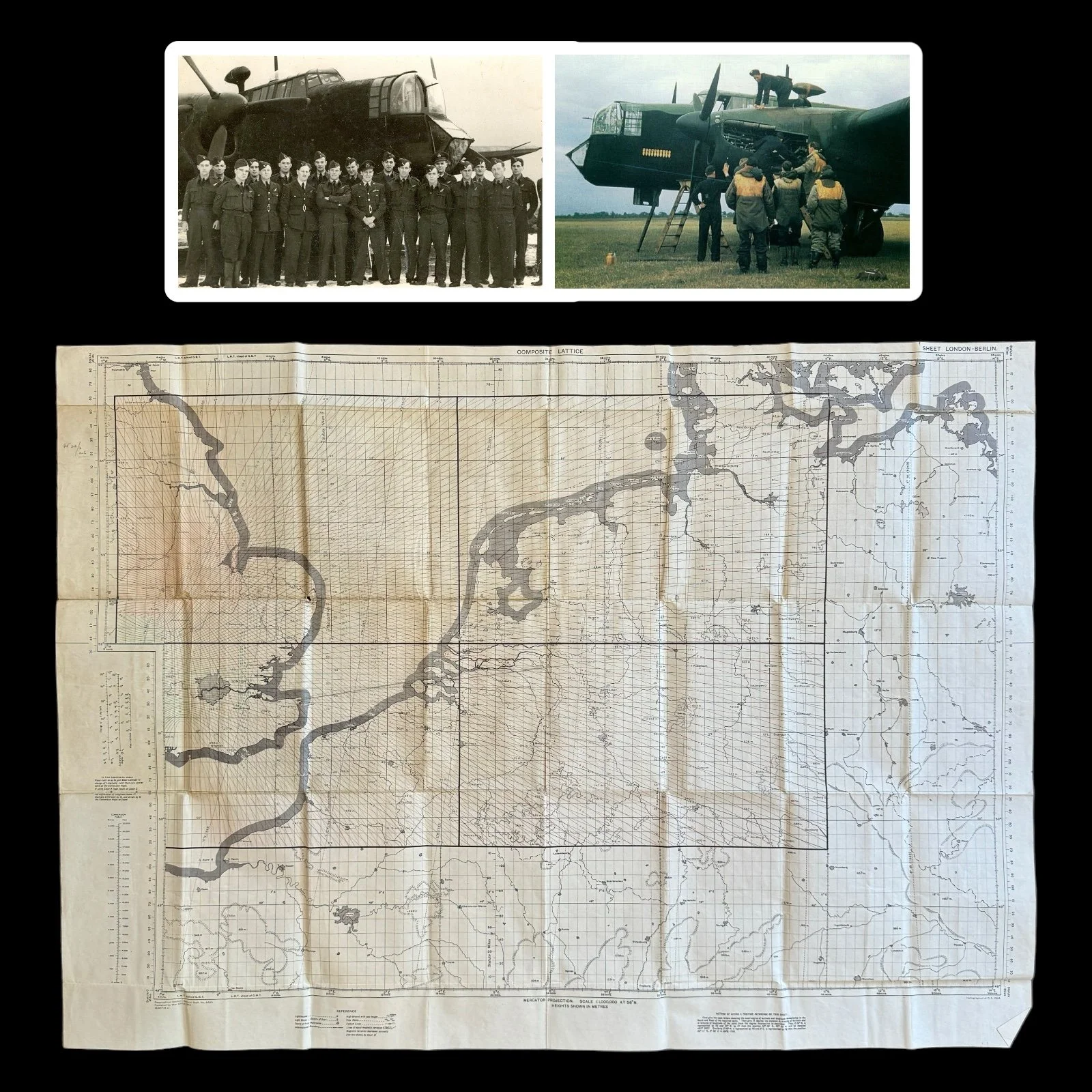VERY RARE! WWII Royal Air Force No. 77 Squadron Composite Lattice “LONDON TO BERLIN” RAF Bomber Command Combat Air Navigation Map
















































VERY RARE! WWII Royal Air Force No. 77 Squadron Composite Lattice “LONDON TO BERLIN” RAF Bomber Command Combat Air Navigation Map
Comes with a hand-signed C.O.A.
“RAF No. 77 Squadron participated in five of the main force raids against Berlin. During the “battle” Halifax II and V aircraft, with which the Squadron was equipped, suffered a greater loss rate than any other aircraft type.”
This extremely rare and museum-grade WWII Royal Air Force No. 77 Squadron Composite Lattice “LONDON TO BERLIN” combat air navigation map was used by during RAF Bomber Command aerial mission on central Germany from 1944 to 1945. Dated 1944, this specialized map was used by No. 77 Squadron Handley Page Halifax Mks III and VI RAF navigators on missions from RAF FULL SUTTON airfield to their aerial target missions in the European Theater. This map is heavily marked with combat mission navigational flight paths from their missions from their Bomber Command base at FULL SUTTON across the North Sea into Germany. There are mission marks flying over/near ANTWERP, TILLBURG, ESSEN, HAMM, and OSNABRUCK.
The Royal Air Force No. 77 Squadron in WWII: A Study of Strategic Bombing and Technological Progression
World War II marked an era of significant military innovations and strategies, among which aerial bombardment campaigns played a crucial role in the Allied victory. The Royal Air Force's Bomber Command, responsible for the aerial bombing campaigns over Germany, was a critical component of the strategic air offensive against the Axis powers. No. 77 Squadron, a unit within the RAF Bomber Command, was particularly noteworthy for its operations from 1944 to 1945. This research explores the contributions of No. 77 Squadron, focusing on its use of the Handley Page Halifax Mks III and VI bombers, and the challenges faced by its navigators during missions from RAF Full Sutton to various targets in central Germany.
Formation and Early Years
No. 77 Squadron, initially part of the RAF’s Coastal Command, was reformed at RAF Finningley in October 1941 under Bomber Command. Equipped with Whitley bombers, the squadron participated in various missions over Germany. However, as the war progressed, the need for more capable aircraft became apparent, leading to the squadron's re-equipment with the Handley Page Halifax bombers in 1942. This transition marked a new phase in the squadron’s operational capability, setting the stage for its significant role in the strategic bombing campaign over German-occupied Europe.
Transition to Handley Page Halifax Mks III and VI
By 1944, No. 77 Squadron had transitioned to flying the more advanced Halifax Mk III and later, the Mk VI versions. These aircraft featured increased range and payload capacity, crucial for the deep penetration strikes intended to cripple the German war economy. The Halifax Mk III, introduced in 1943, was powered by Bristol Hercules XVI engines, which offered better altitude and speed performance compared to earlier models. This version also featured improved defensive armament and radar equipment, enhancing crew survivability during night operations over heavily defended targets like Berlin and the Ruhr Valley.
The introduction of the Halifax Mk VI towards the end of 1944 further enhanced operational capabilities with its higher altitude performance, which was critical during winter missions when the jet stream could adversely affect bombing accuracy. These technological advancements were vital as No. 77 Squadron participated in some of the most challenging bombing operations, including those targeting industrial and military installations in central Germany.
Operations from RAF Full Sutton
In May 1944, No. 77 Squadron moved to RAF Full Sutton, a newly constructed airfield in Yorkshire. From here, the squadron launched numerous sorties into the heart of Germany. The airfield's strategic location allowed for extended range missions deep into enemy territory, critical for the success of the Allied bombing campaign.
The strategic importance of No. 77 Squadron's missions cannot be overstated. Targeting key industrial centers, such as those in Leipzig, Chemnitz, and Dresden, the squadron played a vital role in degrading the German war machine. These missions were hazardous due to dense anti-aircraft fire and the presence of night fighters. The squadron’s operations over Germany during this period were integral to the success of the Allied campaign to undermine Germany’s industrial capabilities, which were crucial for the Nazi war effort.
The Role of Navigators and Technological Support
The success of aerial missions heavily depended on the skill and expertise of RAF navigators. Navigators in No. 77 Squadron faced the daunting task of guiding their aircraft through night skies, often under adverse weather conditions, using a combination of celestial navigation, dead reckoning, and the sophisticated H2S radar navigation system. The H2S was a ground-mapping radar system that helped identify targets at night or through cloud cover, significantly improving bombing accuracy.
Navigators were the linchpin in ensuring that the Halifax bombers reached their targets and returned safely, often navigating under extreme pressure. Their role became even more crucial as the Luftwaffe increased their night fighter operations, requiring navigators to employ complex evasion tactics and constantly adapt their routes to mitigate the risks from enemy defenses.
The operations of No. 77 Squadron from RAF Full Sutton between 1944 and 1945 highlight the evolution of aerial warfare strategies during World War II. The squadron’s use of advanced versions of the Halifax bomber reflects a period of significant technological advancement in aircraft design and capability. The navigators’ skills and the strategic use of technology such as the H2S radar played a pivotal role in the successful execution of bombing missions over central Germany, contributing to the eventual Allied victory. The legacy of No. 77 Squadron, characterized by courage, innovation, and precision, remains a significant chapter in the history of the Royal Air Force and its contribution to the strategic bombing offensive during World War II.